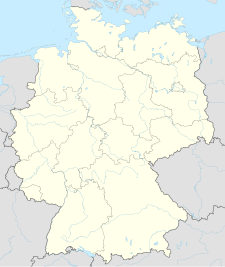Mittelbau-Dora
| Nordhausen-Dora | |
|---|---|
| Concentration camp | |

Germans from Nordhausen burying the dead of Mittelbau-Dora
|
|
| Coordinates | 51°32′7.8″N 10°44′54.8″E / 51.535500°N 10.748556°ECoordinates: 51°32′7.8″N 10°44′54.8″E / 51.535500°N 10.748556°E |
| Other names | Mittelbau-Dora |
| Location | Nordhausen, Germany |
| Operated by | Schutzstaffel (SS) |
| Commandant |
|
| Original use | Subterranean fuel depot (tunnels) |
| Operational | 28 August 1943 – early April 1945 |
| Liberated by | US Army (remaining installations) |
| Notable inmates | Jean Améry, Heinz Galinski |
Mittelbau-Dora (also Dora-Mittelbau and Nordhausen-Dora) was a German Nazi concentration camp located near Nordhausen in Thuringia, Germany. It was established in late summer 1943 as a subcamp of Buchenwald concentration camp, supplying labour for extending the nearby tunnels in the Kohnstein and for manufacturing the V-2 rocket and the V-1 flying bomb. In the summer of 1944, Mittelbau became an independent concentration camp with numerous subcamps of its own. In 1945, most of the surviving inmates were evacuated by the SS. On 11 April 1945, US troops freed the remaining prisoners. Around one in three of the roughly 60,000 prisoners who were sent to Mittelbau did not survive.
Today, the site hosts a memorial and museum.
In early summer 1943, mass production of the A4 (later better known as V-2, V standing for Vergeltung or retribution) ballistic rocket started at the Heeresanstalt Peenemunde on the Baltic island of Usedom as well as at the Raxwerke in Wiener Neustadt, Austria and at the Zeppelin works in Friedrichshafen on Lake Constance.
On 18 August 1943, a bombing raid by the Royal Air Force on Peenemünde ("Operation Hydra") seriously damaged the facilities and ended construction of V-2s there. Other air raids had damaged the other two sites in June and August. As a result, the Nazi leadership accelerated plans to move military construction to areas less threatened by Allied bombers. On 22 August 1943, Adolf Hitler ordered SS leader Heinrich Himmler to use concentration camp workers in future A4/V-2 production. One of the sites selected was at the mountain known as Kohnstein, near Nordhausen in Thuringia. Since 1936, the Wirtschaftliche Forschungsgesellschaft (WIFO) (English: Economic Research Company) had been building a subterranean fuel depot for the Wehrmacht there. By late summer 1943, this was almost finished.
...
Wikipedia

